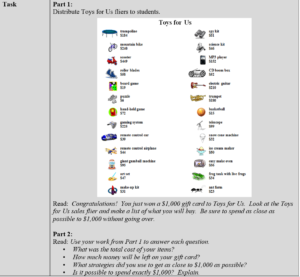Fluently add and subtract within 1000 using strategies and algorithms based on place value, properties of operations, and/or the relationship between addition and subtraction.
[divider] [/divider] Students are able to…
- Use a variety of models and strategies to solve problems that involve addition and subtraction within 1000.
- Explain their strategies and determine whether their answer is reasonable.
- Connect addition and subtraction strategies to place value.
[divider] [/divider] Students are able to…because teachers:
- Ask questions that have students make connections between addition and subtraction strategies and place value.
- Pose tasks that allow students to use a variety of strategies based on their understanding of addition and subtraction.
- Provide opportunities for the students to share their strategies and justify their thinking.
[divider] [/divider] Questions to ask students:
- How can an open number line be used to solve this problem?
- Sample answer that indicates understanding: Student draws a line and labels one of the numbers in the problem and then makes jumps on the number line by hundreds, tens or to the nearest friendly number.
- Can you explain the strategy you are using using place value vocabulary?
- Sample answer that indicates understanding: I would trade a hundred for 10 tens, and then trade a ten to have 13 ones so that I can subtract ones…
- Sample answer that indicates an incomplete understanding or a misconception: I cross out the___ and make it___, then I cross off ___ and make it___…
[divider] [/divider] FSA Notes
Cognitive Complexity Level: 1 – Recall
Achievement Level Descriptors:
2- adds and subtracts within 1,000 when regrouping is not required
3- fluently adds and subtracts within 1,000 using strategies and algorithms based on place value, properties of operations, and/or the relationship between addition and subtraction
4- fluently adds and subtracts within 1,000; explains the method used in finding a sum or difference
5- determines an error and shows the correct answer
Assessment Limits:
Addends and sums are less than or equal to 1,000.
Minuends, subtrahends, and differences are less than or equal to 1,000.
Items may not require students to name specific properties.
[divider] [/divider] Additional Resources:
Additional in depth content knowledge
Blog Posts:
Top 5 Things to Consider when Teaching …
The Struggle can be Real When Subtracting
LearnZillion Videos:
Solve Addition Problems Using the Partial Sums Method
Add Three Digit Numbers with Base-ten Blocks
Solve Addition Problems Using a Number Line
Solve Subtraction Problems Using a Number Line
Subtract Numbers Within 100 Using Base-ten Blocks
Solve Subtraction Problems Using Regrouping
[divider] [/divider] Sample Formative Assessment Task
[divider] [/divider] Resources/Tasks to Help your Child at Home
As your child is making sense of addition and subtraction strategies, challenge them to use at least two strategies to solve problems and explain how the strategies are alike and how they are different.
Different strategies are more efficient depending on the values in the problem. When your child selects a strategy to use, ask them to justify their choice.
Encourage your child to always estimate the sum or difference prior to solving and use that estimate to check for the reasonableness of their solution.
Addition with virtual base ten blocks: http://goo.gl/5aTbPm
Subtraction with virtual base ten blocks: http://goo.gl/hZdB4
